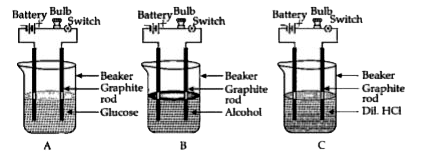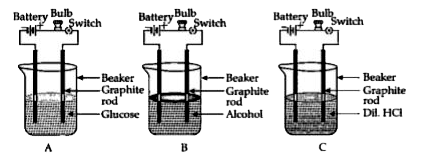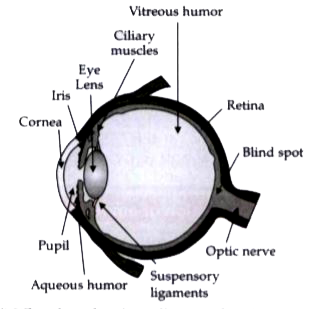Observe the following diagram and answer any four questions from (i) and (v) given below.
During an experiment, Rehana took three beakers A, B and C filled with aqueous solutions of glucose, alcohol and hydrochloric acid respectively as shown in the following figure :

If the property of ion formation is considered, which of the following options is correct ?
Glucose and alcohol solutions do not conduct electricity as they do not have ions.
Dil HCl contains ions so the flow of ions is responsible for the flow of current.
Options (a) and (b) both are correct.
None of the options is correct
The correct Answer is:C
Step by step video, text & image solution for Observe the following diagram and answer any four questions from (i) and (v) given below. During an experiment, Rehana took three beakers A, B and C filled with aqueous solutions of glucose, alcohol and hydrochloric acid respectively as shown in the following figure : If the property of ion formation is considered, which of the following options is correct ? by Chemistry experts to help you in doubts & scoring excellent marks in Class 10 exams.
Topper's Solved these Questions
- BOOK - OSWAL PUBLICATIONCHAPTER - NEW CHAPTERS AND QUESTIONS BASED ON LATEST TYPOLOGIES INTRODUCED BY CBSE FOR 2021-22 EXAMINATION EXERCISE - METALS AND NON- METALS (SELF ASSESSMENT) (OBJECTIVE TYPE QUESTIONS) (A. Multiple Choice Questions)3videos
NEW CHAPTERS AND QUESTIONS BASED ON LATEST TYPOLOGIES INTRODUCED BY CBSE FOR 2021-22 EXAMINATION
- BOOK - OSWAL PUBLICATIONCHAPTER - NEW CHAPTERS AND QUESTIONS BASED ON LATEST TYPOLOGIES INTRODUCED BY CBSE FOR 2021-22 EXAMINATION EXERCISE - METALS AND NON- METALS (SELF ASSESSMENT) (OBJECTIVE TYPE QUESTIONS) (B. Assertion and Reason Type Questions)2videos
NEW CHAPTERS AND QUESTIONS BASED ON LATEST TYPOLOGIES INTRODUCED BY CBSE FOR 2021-22 EXAMINATION
- BOOK - OSWAL PUBLICATIONCHAPTER - NEW CHAPTERS AND QUESTIONS BASED ON LATEST TYPOLOGIES INTRODUCED BY CBSE FOR 2021-22 EXAMINATION EXERCISE - CHEMICAL REACTIONS(VISUAL CASE - BASED QUESTIONS )11videos
NEW CHAPTERS AND QUESTIONS BASED ON LATEST TYPOLOGIES INTRODUCED BY CBSE FOR 2021-22 EXAMINATION
- BOOK - OSWAL PUBLICATIONCHAPTER - METALS AND NON-METALSEXERCISE - Board corner(Long answer type questions)20videos
METALS AND NON-METALS
- BOOK - OSWAL PUBLICATIONCHAPTER - NTSE 2019 - 20 EXERCISE - (CHEMISTRY) ATOMS AND MOLECULES (STAGE - 2)1videos
NTSE 2019 - 20
Similar Questions
Suhana takes three beakers, A, B and C filled with aqueous solutions of glucose, alcohol and hydrochloric acid repectively as shown in the following figure.

The bulb glows in a solution depending on whether the solution is:View SolutionSuhana takes three beakers, A, B and C filled with aqueous solutions of glucose, alcohol and hydrochloric acid repectively as shown in the following figure.

Which of the following statement is true if alcohol is replaced with NaOH solution:View Solution
Knowledge Check
- Question 1 - Select One
Observe the following diagram and answer any four questions from (i) and (v) given below.
During an experiment, Rehana took three beakers A, B and C filled with aqueous solutions of glucose, alcohol and hydrochloric acid respectively as shown in the following figure :

Which of the following statements is correct in terms of glowing of bulb when the switch of ON ?ABulb A and B do not glow but bulb C glows.BBulb A and C do not glow but bulb B glows.CNone of the bulb glow.DAll the bulb glow. - Question 2 - Select One
Observe the following diagram and answer any four questions from (i) and (v) given below.
During an experiment, Rehana took three beakers A, B and C filled with aqueous solutions of glucose, alcohol and hydrochloric acid respectively as shown in the following figure :

Which of the following (major ions) are present in a dilute aqueous solution of hydrochloric acid ?AH3O++Cl−BH3O++OH−CCl−+OH−DUnionized HCl - Question 3 - Select One
Observe the following diagram and answer any four questions from (i) and (v) given below.
During an experiment, Rehana took three beakers A, B and C filled with aqueous solutions of glucose, alcohol and hydrochloric acid respectively as shown in the following figure :

Though the compounds such as glucose and alcohol have hydrogen atoms in their molecules yet they are not categorised as acids. It be because :AAs glucose and alcohol do not produce H+ ions, when dissolved in water.BAs glucose and alcohol produce H+ ions, when dissolved in waterCThey both are ionic compounds.DNone of these
Suhana takes three beakers, A, B and C filled with aqueous solutions of glucose, alcohol and hydrochloric acid repectively as shown in the following figure.

Which of the following statement is correct in terms of glowing of bulb when the switch is ON?View SolutionSuhana takes three beakers, A, B and C filled with aqueous solutions of glucose, alcohol and hydrochloric acid repectively as shown in the following figure.

Which of the following are present in a dilute aqueous solution of hydrochloric acid?View SolutionObserve the following diagram and answer any four questions from (i) and (v) given below.
During an experiment, Rehana took three beakers A, B and C filled with aqueous solutions of glucose, alcohol and hydrochloric acid respectively as shown in the following figure :

What change will be noticed if the content of beaker B is replaced by sodium hydroxide solution ?View SolutionObserve the following diagram and answer any four questions below:

What does the given diagram show?View SolutionObserve the following diagram and answer any four questions below:

_____ works like a screen, on which image is formed.View Solution
